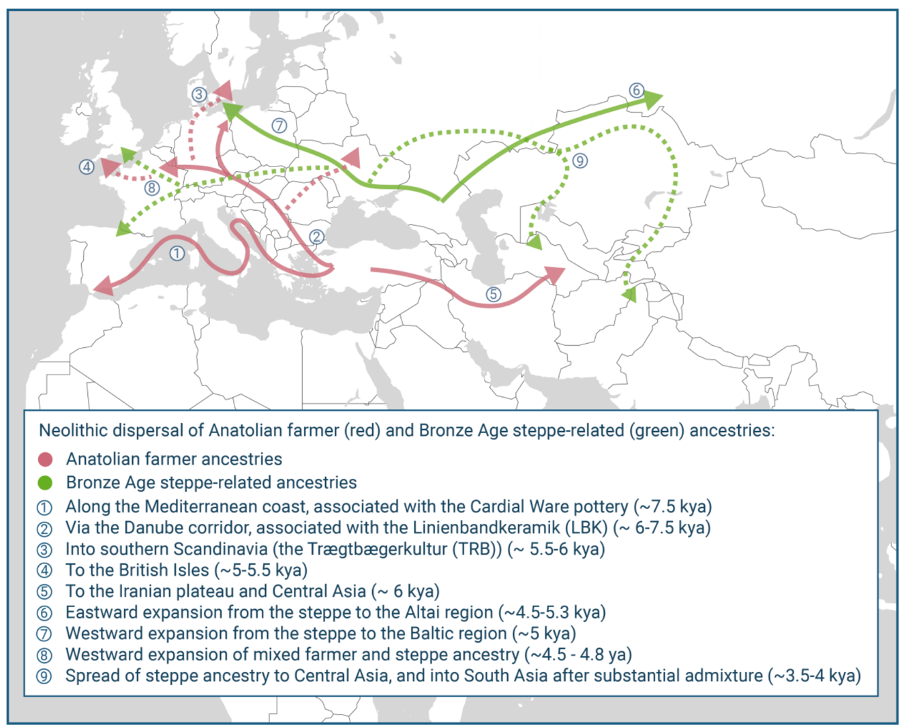Agricultural expansion and migrations over the last 10,000 years significantly influenced genetic, cultural and linguistic diversity across the globe
30 May 2024

This review delves into the expansive journey of human history over the last 10,000 years, a period known as the Holocene. It primarily focuses on how farming, the spread of languages, and the movement of people across the globe are interconnected. Long ago, as humans transitioned from hunting-gathering to farming, where and how people lived, and also the languages they spoke were profoundly affected. We looked into the latest advances in
studying human DNA, including from ancient remains, to trace these migrations and cultural changes.
One of the key themes presented is the exploration of how agriculture spread worldwide. There are two main theories about this. One is ‘demic diffusion’, which suggests that farmers moved, taking their agricultural practices and languages with them. Second is ‘cultural diffusion’, where instead of moving, the farmers influenced their neighboring hunter-gatherer communities to adopt both farming and their languages.
We highlight the profound impact of agricultural expansion and migrations on the genetic, cultural, and linguistic landscapes across different global regions. Particularly noteworthy are the Bantu expansions in Africa, the Neolithic and Bronze Age shifts in Europe and Asia, the Austronesian spread in Island Southeast Asia and Oceania, and the unique interplay of agriculture and language in the Americas.
The paper paints a picture of human history that is intricate and varied. It shows that our past is not a straightforward story of migrations and cultural shifts but is a rich tapestry of interactions, adaptations, and exchanges that have shaped the human story across millennia.
Significance of the study
Our review article significantly contributes to the discourse on human history by integrating genomic data with archaeological and linguistic evidence to unravel the complex patterns of human dispersals during the Holocene era (~10,000 years ago to the present). Our comprehensive analysis of genetic studies across different continents,
including those involving ancient DNA, offers groundbreaking insights into the movements and interactions of human populations. This multidisciplinary approach not only corroborates but also challenges traditional archaeological and linguistic theories, particularly concerning the spread of agriculture and language families. By highlighting the dynamic interplay between demic diffusion (migration of farmers with their lifestyle and languages) and cultural diffusion (adoption of farming and language by hunter-gatherers), our work underscores the complexity of these processes, emphasizing that they are not homogenous but vary greatly across different regions and cultural contexts.
The article’s exploration of various global regions, each with its unique genetic, archaeological, and linguistic narrative, is another significant contribution. In Africa, we discussed the genetic homogeneity due to the expansion of food-producing groups and detailed the multifaceted nature of the Bantu expansion. In Europe, we brought to light the Neolithic transition and the profound impact of Bronze Age migrations from the steppes. Similarly, the article addresses the spread of farming in Central and South Asia, East Asia, and Mainland Southeast Asia, and the Austronesian expansion in Island Southeast Asia and Oceania. By doing so, it paints a vivid picture of the human past, showing how different regions experienced varying degrees of interaction between expanding farmers and
indigenous hunter-gatherers. This regional focus is crucial for understanding the diverse outcomes of these interactions, which ranged from near-complete replacement of indigenous populations to extensive admixture.
Finally, our review’s emphasis on the need for further research marks a significant contribution to ongoing scholarly discourse. We call for more comprehensive genetic studies, particularly in regions where ancient DNA analysis is challenging, to deepen our understanding of human migrations. Moreover, the review advocates for interdisciplinary
research, combining genomic data with sociocultural investigations, to elucidate the complex historical processes that shaped human societies. This perspective not only enriches our understanding of the past but also informs current discussions on human diversity and intercultural interactions, making the review a pivotal reference point for future research in human history and evolutionary studies.
Authors: Mark Stoneking (Department of Evolutionary Genetics, Max Planck Institute for Evolutionary Anthropology/Université Lyon 1, CNRS, Laboratoire de Biométrie et Biologie Evolutive), Leonardo Arias (Department of Evolutionary Genetics, Max Planck Institute for Evolutionary Anthropology/Leiden University Centre for Linguistics), Dang Liu (Department of Evolutionary Genetics, Max Planck Institute for Evolutionary Anthropology/Human Evolutionary Genetics Unit, Institut Pasteur), Sandra Oliveira (Department of Evolutionary Genetics, Max Planck Institute for Evolutionary Anthropology/Computational and Molecular Population Genetics, Institute of Ecology and Evolution, University of Bern), Irina Pugach (Department of Evolutionary Genetics, Max Planck Institute for Evolutionary Anthropology) and Jae Joseph Russell B. Rodriguez (Department of Evolutionary Genetics, Max Planck Institute for Evolutionary Anthropology/Genetics and Molecular Biology Division, Institute of Biological Sciences, College of Arts and Sciences, University of the Philippines Los Baños/DNA Analysis Laboratory, Natural Sciences Research Institute, College of Science, University of the Philippines Diliman)
Read the full paper: https://www.pnas.org/doi/10.1073/pnas.2209475119
